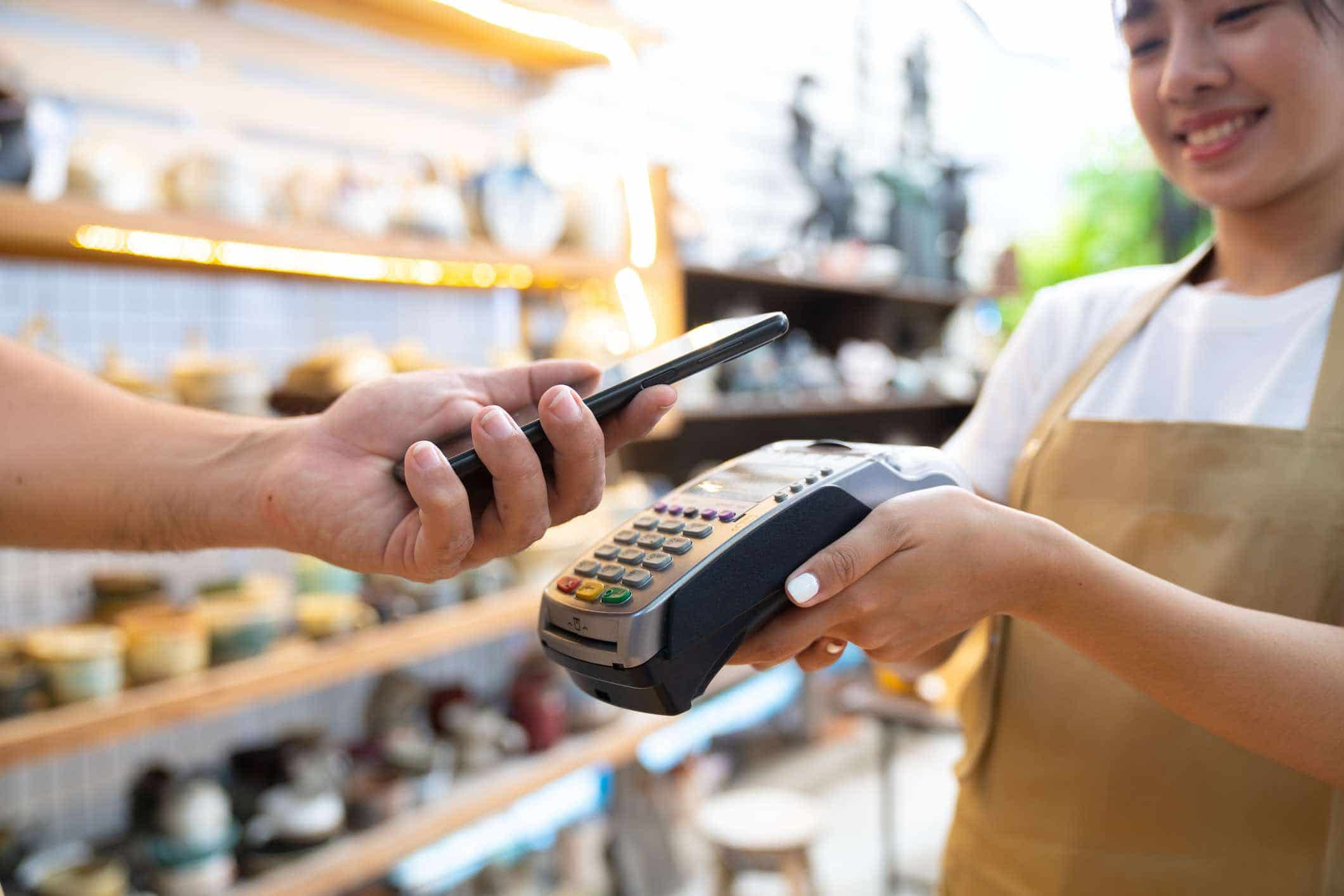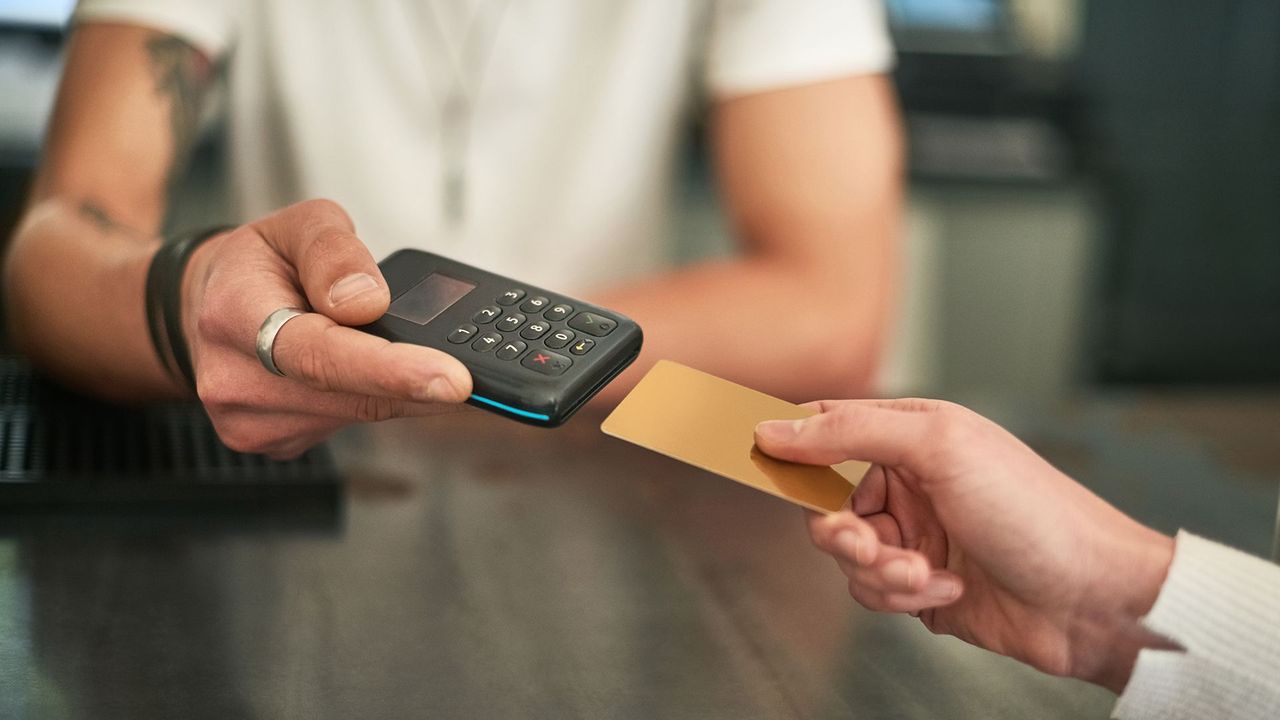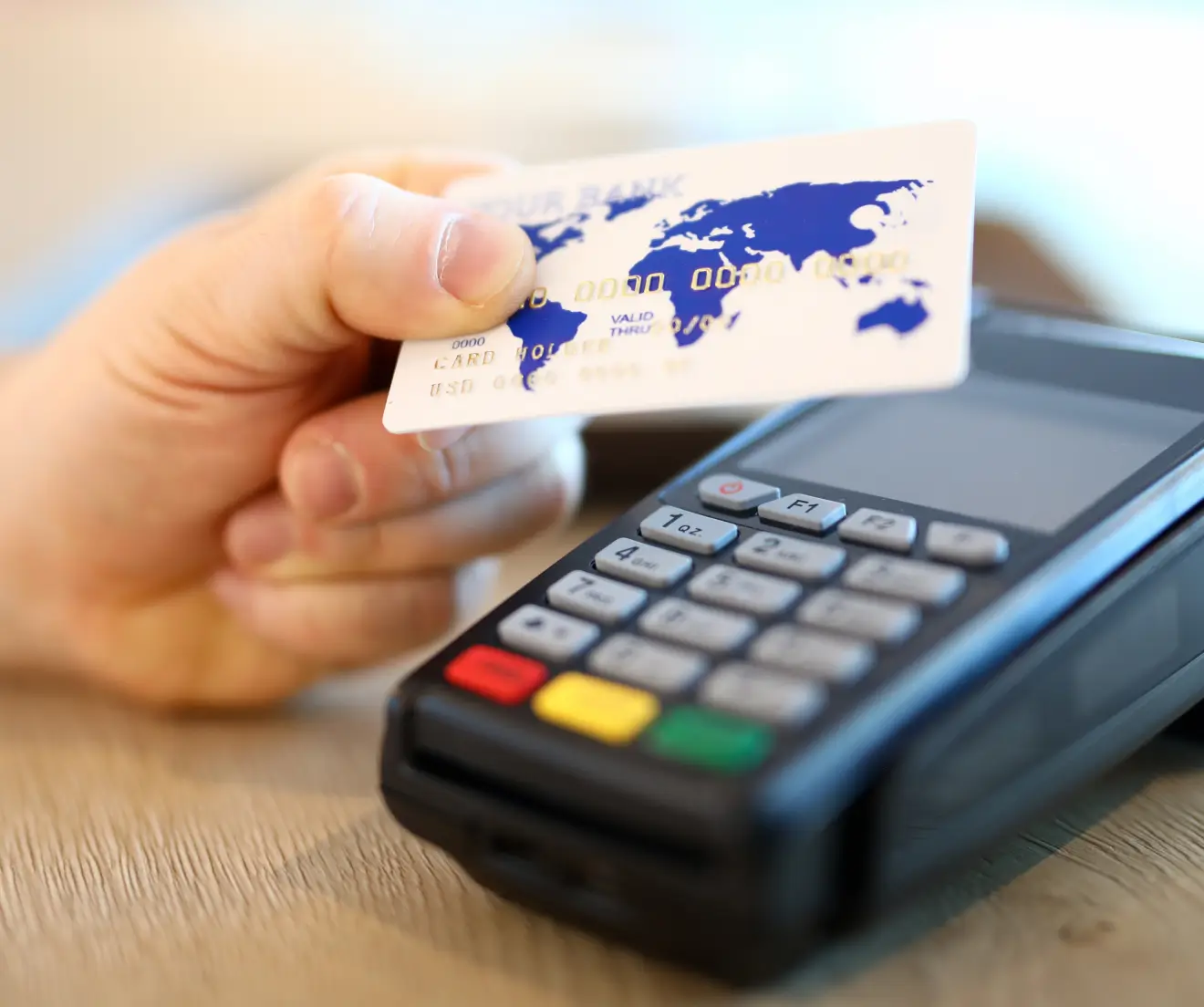Introduction
Welcome to the world of cashless Point of Sale (POS) systems! As technology continues to advance, businesses are adopting payment solutions that eliminate the need for physical cash transactions. Cashless POS systems offer a convenient and secure way for customers to make purchases using digital forms of payment such as credit cards, mobile wallets, and contactless payments.
In recent years, cashless transactions have gained popularity due to their ease of use and the numerous benefits they bring to businesses and consumers alike. Whether you’re a small retail shop, a restaurant, or an e-commerce business, implementing a cashless POS system can revolutionize the way you accept payments, streamline your operations, and enhance the overall customer experience.
By embracing cashless technology, businesses can offer their customers a seamless and efficient purchasing process. Instead of fumbling for cash or dealing with loose change, customers can simply tap their cards or smartphones to make payments. This not only saves time but also reduces the risk of errors in transactions and eliminates the need for manual cash handling.
Additionally, cashless POS systems provide businesses with valuable insights and data. With real-time analytics and reporting capabilities, merchants can gain a deeper understanding of consumer behavior, track sales trends, and make informed business decisions. This data-driven approach enables businesses to optimize their operations, personalize offers, and build strong customer relationships.
In this article, we will explore the concept of cashless POS systems in greater detail. We will delve into the benefits they offer, how they work, the different types available, and what factors to consider when choosing a system for your business. Additionally, we will provide valuable tips for successfully implementing a cashless POS system and integrating it seamlessly into your operations.
So, whether you’re a business owner considering the switch to cashless payments or simply curious about this innovative technology, let’s dive in and discover the world of cashless POS and how it can elevate your business to new heights.
What is Cashless POS?
Cashless Point of Sale (POS) refers to a system that enables businesses to accept payments digitally, eliminating the need for physical cash transactions. With a cashless POS system, customers can make payments using credit or debit cards, mobile wallets, or other digital payment methods. This technology has revolutionized the way businesses handle transactions and has become increasingly popular due to its convenience and efficiency.
Traditionally, businesses relied on physical cash registers to process transactions. However, cashless POS systems have transformed this process by allowing customers to make payments electronically. Instead of a cash register, these systems utilize secure hardware and software components to facilitate digital payment transactions.
One of the fundamental components of a cashless POS system is a card reader or NFC (Near Field Communication) device. This device interacts with the customer’s payment card or mobile device to securely transmit payment details and authorize the transaction. The system connects to the payment processor, which communicates with the customer’s bank or payment provider to complete the transaction.
A cashless POS system offers several advantages for both businesses and customers. From a business perspective, it simplifies the payment process, reduces the risk of errors and theft associated with cash handling, and improves overall operational efficiency. Additionally, cashless transactions provide businesses with valuable data and insights that can be used to analyze sales trends, customer behavior, and optimize marketing strategies.
For customers, cashless POS systems offer convenience and flexibility. They no longer have to rely on carrying physical cash or worry about having exact change. With the rise of mobile wallets and contactless payments, customers can simply tap their smartphones or payment cards to complete transactions quickly and securely.
Furthermore, cashless POS systems enable businesses to offer additional services such as loyalty programs, digital receipts, and seamless integration with e-commerce platforms. These features enhance the overall customer experience and provide added value.
In the next section, we will explore the various benefits that cashless POS systems bring to businesses and why they are becoming increasingly popular in today’s digital era.
Benefits of Cashless POS
Cashless Point of Sale (POS) systems offer a wide range of benefits for businesses that choose to embrace digital payments. Let’s explore some of the key advantages:
- Convenience: Cashless transactions provide convenience for both merchants and customers. Customers can make quick and hassle-free payments by simply tapping their cards or smartphones, eliminating the need to carry physical cash.
- Improved Security: Cashless POS systems enhance security by reducing the risk of theft and fraud associated with cash handling. Digital payment methods utilize encryption and authentication technologies to protect sensitive customer information.
- Efficiency: With cashless transactions, businesses can streamline their operations and reduce time spent on handling cash, counting change, and dealing with cash register discrepancies. This enables employees to focus on serving customers and providing a better shopping experience.
- Reduced Errors: Manual cash handling can lead to errors in giving correct change or miscounting cash. By implementing a cashless POS system, businesses can eliminate errors and ensure accurate and precise transactions.
- Data Insights: Cashless transactions provide valuable data and insights that can be used to understand customer behavior, track sales trends, and make informed business decisions. Merchants can access real-time analytics and reporting, enabling them to optimize their marketing strategies and personalize offers.
- Streamlined Inventory Management: Cashless POS systems integrate with inventory management systems, allowing businesses to track product sales in real-time. This helps prevent out-of-stock situations and enables efficient stock replenishment.
- Increased Sales Opportunities: Accepting digital payments broadens a business’s potential customer base. In an increasingly cashless society, businesses that only accept cash may miss out on sales opportunities from customers who prefer digital payment methods.
- Enhanced Customer Experience: Cashless transactions offer a seamless and frictionless shopping experience. Customers appreciate the ease and speed of payments, leading to increased customer satisfaction and loyalty.
By embracing cashless POS systems, businesses can enjoy these and many other benefits that contribute to improved efficiency, security, and customer satisfaction. Let’s now delve deeper into how cashless POS systems work and the different types available.
How Does Cashless POS Work?
Cashless Point of Sale (POS) systems provide businesses with the ability to accept digital payments from customers. The process involves several key components working together seamlessly. Here’s a breakdown of how cashless POS systems work:
- Hardware: To facilitate digital payments, businesses require specific hardware components. This typically includes a card reader or NFC device that can read payment cards and mobile devices for contactless payments. These devices are connected to a computer or tablet that serves as the central hub for processing transactions.
- Software: Cashless POS systems rely on software applications to process transactions, manage inventory, and generate reports. The software allows businesses to input product information, calculate prices, and handle various payment methods.
- Payment Processing: When a customer makes a purchase, the cashless POS system interacts with the customer’s payment card or mobile device to securely transmit payment details. The system then connects to a payment processor or gateway, which authorizes and verifies the transaction with the customer’s bank or payment provider.
- Transaction Completion: Once the transaction is authorized, the payment processor signals the cashless POS system, confirming the successful completion of the payment. The system then generates a receipt, which can be provided digitally or in print to the customer. In some cases, the system may also provide the option to send the receipt via email.
- Record Keeping and Reporting: Cashless POS systems store transaction data, allowing businesses to keep accurate records of sales. This data can be used for financial reporting, inventory management, and analysis of sales trends.
Cashless POS systems are versatile and can support a variety of payment methods, including credit and debit cards, mobile wallets such as Apple Pay and Google Pay, and digital payment platforms like PayPal. Customers can simply tap their cards or mobile devices on the card reader or NFC device to initiate the payment process.
It is important to note that cashless POS systems require an internet connection to process transactions. This can be either through a stable Wi-Fi connection or a mobile data plan, ensuring seamless communication between the system, payment processor, and customer’s banking institution.
Overall, cashless POS systems simplify the payment process for businesses and customers. By leveraging the power of hardware, software, and secure payment processing, these systems provide a reliable and efficient way to conduct digital transactions.
In the next section, we will delve into the different types of cashless POS systems available to businesses.
Types of Cashless POS Systems
As businesses embrace cashless transactions, there are several types of cashless Point of Sale (POS) systems available to cater to different business needs. Let’s explore some of the common types of cashless POS systems:
- Traditional POS Systems: Traditional POS systems are hardware-based systems that include a cash register, barcode scanner, and receipt printer. These systems can be upgraded with additional components such as card readers and NFC devices to accept digital payments. Traditional POS systems are ideal for brick-and-mortar businesses that require a complete solution for managing inventory, sales, and customer data.
- Mobile POS Systems: Mobile POS systems leverage smartphones or tablets as the primary device for processing transactions. These systems usually involve a downloadable app that transforms the mobile device into a fully functional cash register. Mobile POS systems are popular among small businesses, pop-up shops, food trucks, and other mobile merchants due to their flexibility and affordability.
- Tablet-based POS Systems: Tablet-based POS systems are similar to mobile POS systems but are designed for larger businesses with fixed locations. These systems offer a wider range of functionalities and can be customized to meet specific business requirements. Tablet-based POS systems provide a sleek and modern solution for businesses, enabling them to efficiently process transactions without the need for bulky hardware.
- Online POS Systems: Online POS systems, also known as cloud-based POS systems, are hosted on remote servers and accessed via the internet. These systems offer businesses the flexibility to manage their operations from anywhere with an internet connection. Online POS systems are particularly beneficial for e-commerce businesses as they integrate seamlessly with online shopping carts, inventory management, and order fulfillment systems.
- Self-Service Kiosks: Self-service kiosks are becoming increasingly popular in various industries, including retail, food service, and hospitality. These kiosks allow customers to independently select products, customize orders, and complete transactions using digital payment methods. Self-service kiosks not only streamline the payment process but also reduce wait times and enhance the overall customer experience.
Each type of cashless POS system offers unique features and benefits. The choice of system depends on factors such as business size, industry, budget, and specific requirements. It’s important for businesses to assess their needs and select a cashless POS system that best aligns with their goals and operations.
In the next section, we will explore the key factors to consider when choosing a cashless POS system for your business.
Integrating Cashless POS with Your Business
Integrating a cashless Point of Sale (POS) system into your business requires careful planning and implementation. Here are key steps to successfully integrate a cashless POS system:
- Evaluate Your Business Needs: Before selecting a cashless POS system, assess your business requirements. Consider factors such as the type of transactions you handle, the volume of sales, and the specific features and functionalities you need. This will help you choose a system that aligns with your business goals.
- Research Available Systems: There are numerous cashless POS systems available, each offering different features and pricing structures. Thoroughly research and compare various systems to determine which one best fits your business needs and budget.
- Consider Integration Options: If you already use other software or systems in your business, such as inventory management or accounting software, consider how well the cashless POS system can integrate with these existing systems. Integration allows for seamless syncing of data between different platforms, streamlining your operations.
- Train Employees: Introducing a cashless POS system will require training your employees on how to use the new system effectively. Ensure that your team is familiar with the hardware and software components, understands the payment process, and can address any customer queries or issues that may arise.
- Set Up Payment Options: Configure your cashless POS system to accept a variety of payment methods, such as credit and debit cards, mobile wallets, and digital payment platforms. Ensure that the system is properly connected to your payment processor and that the setup is secure and compliant with payment industry standards.
- Test and Monitor Performance: Once the system is set up, conduct thorough testing to verify that it functions correctly and processes transactions accurately. Monitor the system’s performance closely during the initial stages to identify any potential issues and address them promptly.
- Promote Awareness and Education: Communicate to your customers that you now offer cashless payment options. Display prominent signage and communicate through various channels such as social media and your website, highlighting the convenience and benefits of using digital payment methods.
- Stay Updated: Technology is constantly evolving, and new features and updates are regularly released for cashless POS systems. Stay informed about software updates, security enhancements, and industry trends to ensure that your system remains up-to-date and offers the best possible experience for your business and customers.
Integrating a cashless POS system requires careful planning, implementation, and ongoing maintenance. By following these steps and considering the unique needs of your business, you can seamlessly integrate a cashless POS system and unlock the benefits of digital payments.
In the next section, we will explore key factors to consider when choosing a cashless POS system for your business.
Factors to Consider When Choosing a Cashless POS System
Choosing the right cashless Point of Sale (POS) system is crucial to the success of your business. Here are key factors to consider when selecting a cashless POS system:
- Features and Functionality: Evaluate the features and functionalities offered by different cashless POS systems. Consider which ones are essential for your business, such as inventory management, customer relationship management (CRM), employee management, reporting and analytics, and integration with other systems.
- Scalability: Consider the scalability of the cashless POS system. Will it be able to accommodate your business’s growth in terms of transaction volume, additional locations, or new product lines in the future? Make sure the system can easily scale with your business needs.
- Hardware: Assess the hardware requirements of the cashless POS system. Determine if you need specific types of hardware such as mobile devices, card readers, cash drawers, or receipt printers. Consider the cost and compatibility of the hardware with the system.
- User-Friendliness: Ease of use is crucial for both you and your employees. Ensure the cashless POS system has a user-friendly interface and intuitive navigation. A system that is easy to learn and operate will minimize training time and reduce the likelihood of errors during transactions.
- Security: Security is paramount when handling digital transactions. Choose a cashless POS system that complies with Payment Card Industry Data Security Standard (PCI DSS) requirements. Look for features like end-to-end encryption, tokenization, and fraud detection to protect customer data and ensure secure transactions.
- Payment Processing: Consider the payment options supported by the cashless POS system. Ensure that the system can accept major credit and debit cards, contactless payments, and popular digital payment platforms. Also, confirm that the system is compatible with your preferred payment processor to avoid any compatibility issues.
- Pricing and Fees: Evaluate the pricing structure and fees associated with the cashless POS system. Consider setup costs, hardware costs, transaction fees, monthly fees, and any additional fees for integration or software updates. Choose a system that offers transparent pricing and aligns with your budget.
- Customer Support: Reliable customer support is essential for resolving issues and ensuring smooth operations. Research the customer support options provided by the cashless POS system provider, including availability, response time, and support channels such as phone, email, or live chat.
- Reviews and References: Read reviews and seek references from other businesses that have used the cashless POS system you are considering. This can provide valuable insights into the reliability, functionality, and overall satisfaction level of the system.
By considering these factors, you can make an informed decision when selecting a cashless POS system that is tailored to your business needs and goals. Take the time to evaluate different options and choose a system that aligns with your unique requirements.
In the next section, we will provide tips for implementing a cashless POS system successfully.
Tips for Implementing Cashless POS Successfully
Implementing a cashless Point of Sale (POS) system can bring significant benefits to your business. Here are some tips to ensure a successful implementation:
- Plan Ahead: Develop a clear implementation plan that outlines the key steps and timeline for integrating the cashless POS system into your business. Assign responsibilities to team members and set realistic goals to ensure a smooth transition.
- Train Employees: Provide thorough training to your employees on how to use the cashless POS system effectively. Familiarize them with the hardware, software, and various features. Offer ongoing training and support to address any questions or challenges that may arise.
- Test Thoroughly: Before fully implementing the cashless POS system, conduct thorough testing to ensure that all hardware, software, and payment processing components are working correctly. Test the system with transactions of different types and scenarios to identify and address any issues or bugs.
- Communicate with Customers: Inform your customers about the transition to a cashless POS system. Use various communication channels, such as in-store signage, social media, and email newsletters, to educate them about the benefits of digital payments. Address any concerns or questions they may have to alleviate any potential resistance.
- Offer Technical Support: Provide accessible technical support channels for both your employees and customers. This can include a dedicated support helpline, online resources, and FAQs. Promptly address any technical issues that arise to minimize disruptions to operations.
- Monitor Performance and Analytics: Regularly monitor the performance of your cashless POS system and analyze the data generated. Pay attention to sales trends, customer behavior, and transaction volumes. Use this data to make data-driven decisions, identify areas for improvement, and optimize your operations.
- Regular Updates and Maintenance: Keep your cashless POS system updated with the latest software versions, security patches, and bug fixes. Regularly review and update your hardware components to ensure optimal performance. Stay informed about new features and enhancements offered by the system provider.
- Stay Secure and Compliant: Maintain a strong focus on security and compliance. Adhere to industry standards, such as PCI DSS, and follow best practices for data encryption, user access control, and secure payment processing. Regularly review and update security protocols to protect customer data and maintain trust.
- Solicit Feedback: Encourage feedback from both employees and customers about their experience with the cashless POS system. Take their suggestions and concerns into consideration, and continuously look for ways to improve and enhance the system based on their input.
By following these tips, you can ensure a successful implementation of a cashless POS system in your business. Remember to be patient and adaptable during the process, and address any challenges or issues proactively to maximize the benefits of digital payments.
In the next section, we will conclude our exploration of cashless POS systems and the advantages they bring to businesses.
Conclusion
The adoption of cashless Point of Sale (POS) systems has ushered in a new era of convenience, efficiency, and security in the world of business transactions. By embracing digital payment methods, businesses can streamline operations, enhance the customer experience, and gain valuable insights to drive growth.
Cashless POS systems offer numerous benefits, including increased convenience for customers, reduced errors in transactions, improved operational efficiency, and access to valuable data and analytics. With the ability to accept a variety of payment methods, businesses can cater to the preferences of their customers and stay ahead of the competition in an increasingly cashless society.
When choosing a cashless POS system, it is crucial to consider factors such as features, scalability, user-friendliness, security, payment processing options, and customer support. Careful planning, thorough training, and effective communication will contribute to a successful implementation and integration of the system into your business operations.
Continuously monitoring and analyzing the performance of the cashless POS system, staying updated with the latest updates and features, and prioritizing security and compliance are essential for long-term success. Soliciting feedback from employees and customers and making improvements based on their input will further enhance the system’s effectiveness.
As businesses continue to adapt to the digital landscape, cashless POS systems have become an integral part of modern commerce. By embracing this technology, businesses can provide a seamless and efficient payment experience, boost customer satisfaction, and position themselves for growth in the digital age.
So, whether you’re a small retail shop, a restaurant, or an e-commerce business, it’s time to embark on the journey of embracing cashless POS systems and reaping the benefits in today’s fast-paced business landscape.

























